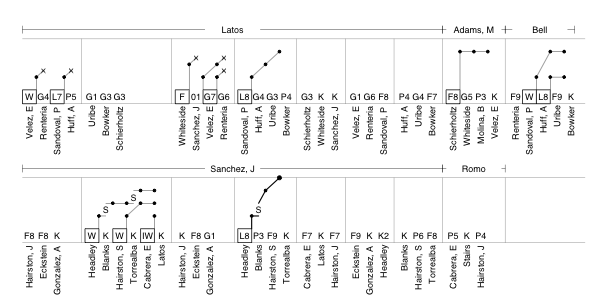
| F/X Visualizations | April 23, 2010 |
Before the season I talked about considering a new box score. I got a lot of great feedback and worked on a second version with a lot of input from Matt Lentzner. I probably created the wrong impression by initially calling the graph a box score, I was corrected that it would be better to consider it a score card. It functions better as such and does not raise the same kind of assumptions (seeing each player's numbers).
Anyway with a couple weeks in the books I wanted to see how the score card did with a handful of the more interesting games played. I should say that it took me a little bit of work to get the system completely automated and I still have some kinks to work out (the end of some innings look like double plays or triple plays when they shouldn't be), if you see any other problems please tell me in the comments so I can try and fix them. I kept the length of each image the same so I didn't push the margin of the page out too far, but this means that each image has a different scale. Click on it for a full sized version.
First off here is a wild game the Padres played on April 12th in which they scored ten runs in a single inning.

That inning included four straight singles followed, later, by three straight doubles and then a home run.
Next I wanted to check out was last Saturday's epic 20-inning match between the Mets and Cardinals.

Here the scaling becomes a big issue. This 20-inning game stretches the score card out very far. Sean Forman suggested the I flip it so that the game progresses down rather than to the left. I like having it go to the left so you 'read' the game as you would a sentence (obviously reading to the left is just the way some people read). But websites scroll down way more than they scroll to the left so having the card progress down would be a more natural flow for web viewing.
Next here is Ubaldo Jimenez's no hitter.

You can see Jimenez actually had quite a number of base runners early in the game. Through the first five innings he gave up six walks, but the last four innings were perfect. I also think there is a balk in there that my algorithm is not picking up.
Next I choose Tuesday's game in which Jonathan Sanchez and the Giants one-hit the Padres, but still lost.

You can see how in the fourth the one hit off Sanchez, a Chase Headley line drive single to center, turned into the game's only run. With Kyle Blanks batting Headley stole 2nd and then advanced to third on Blanks's foul pop out to first. He then scored on Scott Hairston's fly out to right.
Finally here is yesterday's 20-0 rout of the Pirates by the Brewers.

Baseball games are wonderfully diverse and I enjoying thinking about ways of reporting and displaying that diversity. Over the season I want to make some more tweaks to this method, including trying out Sean's suggestion of flipping the orientation.
Comments
Love that I could interpret the game without reading through your method. That's always been a beef of mine with scorecards: unless you know how to keep score, they're jiberish.
You're on to something important here...
Posted by: Dylan at April 23, 2010 8:46 PM
I put together some pdfs that let you score a game by hand more or less using this method. You can download the blank scorecard and an example from my website.
Posted by: Mark Davey at April 24, 2010 9:20 AM
Labeling the bases and innings like Mark's sheet would help to make it quicker to understand where in the game you are. Similarly, replacing dots for runs with the number of runs would make it easier to tell what the score is at any given point. ("1" for the first run. Perhaps "45" on a play where the 4th and 5th runs score?)
On a similar note, "x" seems to either mean a baserunner was forced or tagged out or they were left on base. Like in the top of the 7th in the Braves @ Padres game. When Omar Infante strikes out to end the inning, it also appears Melky Cabrera was thrown out at second. When he was in fact left on first. Perhaps an open circle at first?
This is a great way to see the progression of a game. I look forward to see it come along.
Posted by: elwin at April 25, 2010 5:52 PM
Mark,
Very cool. Thanks for doing that.
Elwin. I like some of those suggestions. Here is an example with those included.
Posted by: Dave Allen at April 25, 2010 8:55 PM
Dave,
Glad to see you're still developing this. Thanks for all the hard work.
Matt
Posted by: Matt Lentzner at April 26, 2010 4:28 PM
Interesting. I also thought that the combined scoring dots lost information. You could see all the singles, doubles, etc. The numbers are better, however, I am not sure I like the aggregate runs as opposed to the number score at that at bat. So the example would be 1-1-2 instead of 1-2-4. This allows you to see how the at-bat (and therefore the batter) produce runs (possible RBIs). And the feel of the score is still there with a count out.
Posted by: Doug Porterfield at April 27, 2010 5:21 AM